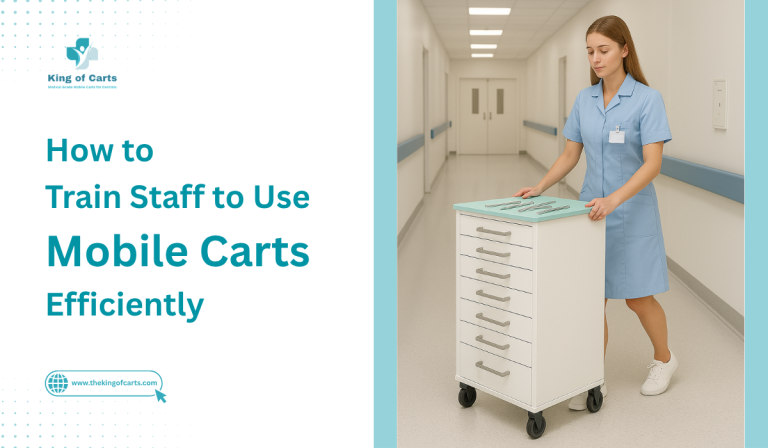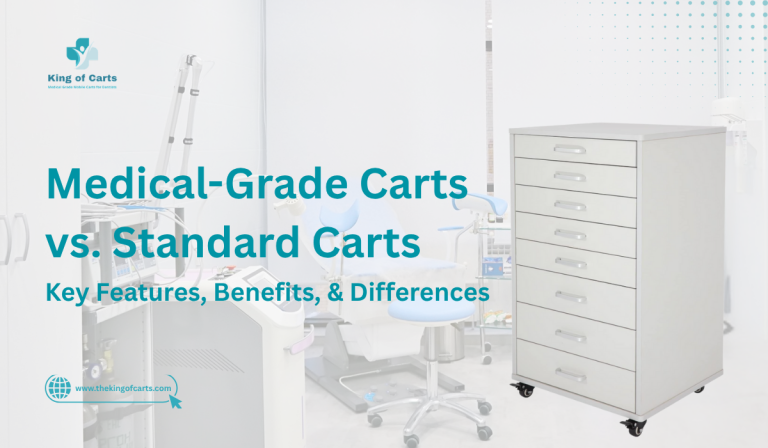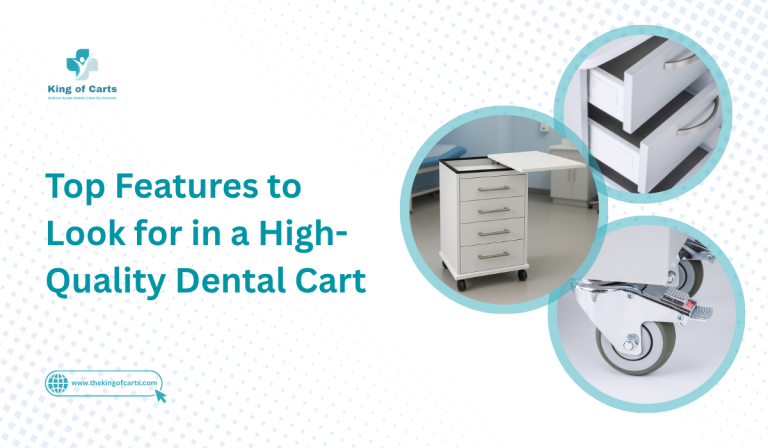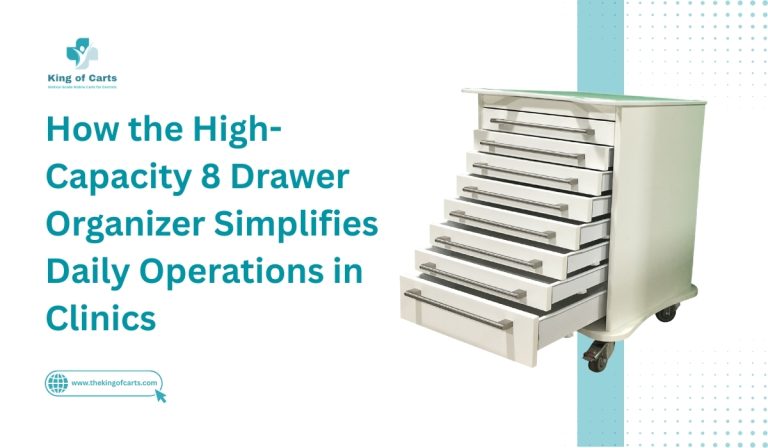In modern healthcare, hygiene is more than a priority—it is the foundation of patient safety. Hospitals, clinics, and dental practices must uphold the highest sanitation standards to prevent infections, reduce risks, and maintain trust among patients. A critical factor that often goes unnoticed in this effort is the use of medical-grade materials.
From surgical instruments to mobile carts and storage units, the materials used in medical environments are not just selected for their strength or appearance. Instead, they are carefully engineered to meet strict hygiene and safety requirements. Unlike ordinary consumer-grade materials, medical-grade materials are designed to resist bacteria, withstand rigorous cleaning, and maintain their structural integrity even under heavy use. This article explores what medical-grade products are, why they matter, and how they play a vital role in enhancing hygiene standards in healthcare and beyond.
What Are Medical-Grade Materials?
Medical-grade materials are specifically developed to meet the safety, durability, and hygiene requirements of healthcare environments. They are designed to endure harsh cleaning agents, frequent sterilization, and high contact use—all while resisting contamination.
Key Characteristics of Medical-Grade Materials:
- Non-Porous Surfaces: Prevents absorption of bacteria, viruses, and fluids.
- Antimicrobial Properties: Many are treated with coatings that inhibit microbial growth.
- Durability: Resistant to scratches, cracks, and corrosion that could otherwise harbor germs.
- Chemical Resistance: Withstands strong disinfectants and sterilization procedures.
- Compliance: Meets international medical standards such as ISO and FDA requirements.
Common Examples
- Antimicrobial Laminates: Used in countertops, cabinets, and touch surfaces.
- Stainless Steel: Used in surgical tools, carts, and surfaces due to its corrosion resistance.
- ABS Plastic: Durable and lightweight, commonly used in medical furniture.
- Epoxy-Coated Metals: Provides water resistance and protection against microbial buildup.
These materials differ significantly from those used in everyday furniture or consumer products. For example, a household cart may use standard steel or plastic, which can rust, absorb stains, or degrade with chemical exposure. In contrast, a medical-grade cart uses non-toxic, non-porous, and antimicrobial-certified materials, ensuring a much higher level of hygiene and reliability.
The Importance of Medical-Grade Materials in Healthcare
- Infection Control: Hospital-acquired infections (HAIs) are a serious concern worldwide, affecting millions of patients each year. One of the most effective ways to reduce HAIs is to ensure that every surface, tool, and piece of equipment is resistant to microbial growth. Medical-grade materials form a first line of defense, reducing the likelihood of germs thriving in hidden crevices or porous surfaces.
- Antimicrobial Coatings: Surfaces enhanced with silver ions, copper, or zinc oxide provide powerful antimicrobial protection. These coatings work by destroying harmful microbes on contact, reducing infection risks, improving sanitation, and ensuring a safer, more hygienic environment in healthcare and clinical settings.
- Easy Cleaning & Maintenance: Medical environments demand constant cleaning. Materials must endure harsh disinfectants, alcohol wipes, and sterilization processes without breaking down. Medical-grade surfaces are engineered to remain intact under repeated cleaning cycles, making them a cost-effective and hygienic choice.
- Durability Under Pressure: Healthcare equipment undergoes heavy use daily—storage carts are moved across wards, surgical trays are sterilized multiple times, and examination chairs handle constant patient traffic. Medical-grade materials are built for this intensity, ensuring long lifespans without compromising on safety.
- Safety & Compliance: Healthcare facilities must comply with strict hygiene and safety regulations. Using certified medical-grade materials ensures compliance with standards like ISO 13485, FDA approvals, and CE markings. This not only guarantees patient safety but also shields institutions from legal or regulatory challenges.
Applications of Medical-Grade Materials
Medical-grade materials are integrated into almost every aspect of healthcare, from small instruments to large-scale equipment.
Hospital and Clinic Furniture
- Mobile carts, drawers, and cabinets.
- Beds, side tables, and IV stands made with stainless steel or coated metal.
Operating Rooms and Surgical Tools
- Scalpels, forceps, surgical trays.
- Operating tables with antimicrobial laminate surfaces.
Dental Practices and Laboratories
- Dental carts, instrument trays, and storage cabinets.
- Autoclave-resistant instruments and lab benches.
Patient Handling Equipment
- Wheelchairs, stretchers, and examination chairs.
- Non-porous upholstery with antimicrobial coatings.
Every item made from medical-grade materials contributes to infection prevention, durability, and long-term hygiene compliance.
How Medical-Grade Materials Enhance Hygiene Standards
- Reduced Risk of Cross-Contamination: Non-porous materials prevent microbes from embedding into surfaces. This ensures that pathogens are easily eliminated during cleaning, significantly reducing infection risks.
- Resistance to Moisture and Corrosion: In medical environments, exposure to fluids is inevitable. Materials like stainless steel and epoxy-coated metals resist rust and moisture damage, maintaining cleanliness and safety over time.
- Compatibility with Disinfectants: Ordinary furniture materials may degrade under strong cleaning agents. In contrast, medical-grade materials remain unaffected by alcohol, chlorine, or peroxide-based cleaners, ensuring consistent hygiene.
- Longevity and Cost-Efficiency: While medical-grade equipment may have higher upfront costs, it lasts much longer than consumer-grade alternatives. This durability reduces replacement frequency and ensures that hygiene standards remain consistently high.
- Patient and Staff Confidence: The presence of visibly clean, high-quality medical furniture and tools fosters trust. Patients feel reassured, and staff can perform their duties with confidence knowing their environment is hygienic and safe.
The Future of Medical-Grade Materials
Innovation is driving new developments in the world of healthcare materials. Beyond stainless steel and ABS plastic, researchers are working on advanced solutions that make hygiene even more reliable and sustainable.
- Nanotechnology: Nanomaterials are being developed to create self-cleaning and germ-resistant surfaces. These could drastically reduce the spread of infections in clinical environments.
- Eco-Friendly Alternatives: Sustainability is becoming a key consideration. Biodegradable polymers and recyclable composites are being engineered to meet medical standards while reducing environmental impact.
- Smart Surfaces: Emerging technologies are incorporating sensors into medical-grade surfaces. These can detect contamination levels or send alerts when cleaning is required, ensuring hygiene is never overlooked.
The healthcare industry is evolving, and medical-grade materials are at the center of this transformation, balancing safety, durability, and environmental responsibility.
Conclusion
Hygiene standards in healthcare are non-negotiable, and medical-grade materials play a crucial role in maintaining them. From infection control to long-term durability, these specialized materials ensure that every tool, surface, and piece of furniture in a medical environment contributes to patient safety. Unlike consumer-grade materials, medical-grade options are non-porous, antimicrobial, chemically resistant, and built to last.
Whether in hospitals, dental practices, or labs, their impact on hygiene is undeniable. By investing in medical-grade materials, healthcare providers not only improve sanitation but also safeguard patients, boost staff confidence, and reinforce their commitment to excellence in care. So, when it comes to buying medical-grade carts, The King of Carts stands out as the go-to choice for quality, safety, and reliability.






